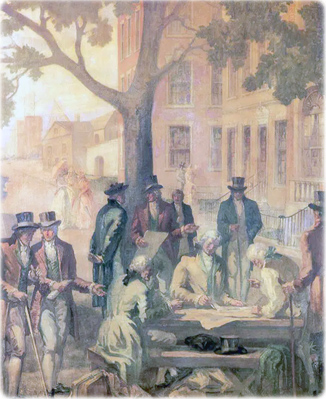
New York Stock Exchange
The New York Stock Exchange, the largest stock exchange in the world, was originally established by a group of 24 stockbrokers, who signed the Buttonwood Agreement, on May 17, 1792, under a buttonwood tree, outside of 68 Wall Street. It set rules about how stocks could be traded and established fixed commissions. The Agreement was a response to the first financial panic in the young United States of America.
The Tontine Coffee House was the meeting place for the group of stockbrokers until 1817. That year, the New York Stock & Exchange Board was formally established on March 8. By this time, New York City had become the main securities market in the US.
From 1817 to 1819, the organization rented a room at 40 Wall Street, where the brokers gathered twice a day to trade a list of 30 stocks and bonds. Thereafter, it occupied three temporary locations until 1827, when it moved to the Merchant's Exchange building until it was destroyed by the Great Fire of 1835, which also destroyed many buildings on Wall Street and many of the institution's historical records.
Then, it occupied three temporary locations from 1835 to 1842.
Telegraph arrived in New York City in the 1830s, telephone in the late 1870s and electric lighting and power in the 1880s.
The Second Merchants' Exchange building was completed in 1842 and the New York Stock Exchange moved into the new building the same year, where it remained until 1854. Then the NYSE occupied the Corn Exchange Bank building until 1856 and then, the Lord's Court building at William and Beaver Streets and Exchange Place until 1865.
In 1863, the name changed to the New York Stock Exchange.
The first permanent home of the NYSE opened at 10 Broad Street, on December 9, 1865. It was built on a portion of its present Broad Street site. The building was reconstructed internally in 1871. By 1879, the NYSE bought adjacent properties on Broad Street and New Street. By 1882 or before, the building was enlarged and expanded.
Stock tickers were introduced in 1867. The ringing of a bell signaling the opening or closing of the day’s trading, was first used in the 1870s. It was then a Chinese gong. Telephones were installed at the NYSE in 1878. On December 15, 1886, trading volume topped 1 million shares and the stock market continued to grow. In 1896, the Dow Jones Industrial Average was first published in the Wall Street Journal.
More: Wall Street in 19th century ►
The NYSE moved into the present 10-story building in 1903, located at 18 Broad Street. It was designed by George Browne Post (1837-1913), who also designed the New York Times Building (41 Park Row), the Western Union Telegraph Building, the Produce Exchange, St. Paul Building, the New York World Building, the Bronx Borough Hall and the Wisconsin State Capitol, among others.
On July 19, 1900, the Board of Managers of the Produce Exchange (Bowling Green) received an application from the Board of Governors of the New York Stock Exchange, requesting that the Produce Exchange accommodate the NYSE from April 15, 1901, to May 1, 1902, during the construction of the new building. Members of the NYSE had settled down in its temporary quarters in the Produce Exchange on April 23, but trading begun on April 29 (Monday).
The last day of trading on the floor of the old building was on April 26 (Friday), when over 800 brokers (more than ever before at the same time) and several spectators came to the farewell scenes. The work of demolition of the old building had already begun. The Western Union Building, at 16 Broad Street (bought in 1898), and the building at 8 Broad Street were also demolished.
Plans for the new building were unanimously adopted by the Governing Committee of the NYSE on December 7, 1900. The present neoclassic New York Stock Exchange building was constructed between September 1901 (cornerstone was laid on September 9) and April 1903. It was built entirely of carved white marble, with a much larger trading floor. It was designated a National Historic Landmark on June 2, 1978.
In 1902, John Quincy Adams Ward (1830-1910), the sculptor of the statue of George Washington on the steps of Federal Hall National Memorial, with the collaboration of Paul Wayland Bartlett, made the models for the marble pediment sculptures for the New York Stock Exchange. The pediment was carved by the Piccirilli Brothers.
The new neoclassical NYSE building was dedicated on April 22, 1903.
Trading Floor and office space were expanded further, in 1922, when the northern annex at 11 Wall Street was completed on the corner of Broad Street and Wall Street. This 23-story building replaced the old Wilks Building. The 11 Wall Street was designed by Trowdridge and Livingston in an effort to complement the 1903 structure.
In 1928, the Quotation Department was developed to provide the most recent stock quotations to member firms. In the 1960s, computer data processing were applied to the NYSE’s market operations.
In October 1929, the New York stock market crashed. It was the most devastating month in the history of the stock market. Recovering was slow. In 1934, Congress passed the Securities Exchange Act, primarily regulating transactions which take place between parties which are not the original issuer, such as trades that retail investors execute through brokerage companies.
In 1995, the auction process on the NYSE shifted towards automation through the use of wireless handheld computers. Since 2007, all NYSE stocks have been traded through its electronic hybrid market. Customers can submit orders for immediate electronic execution.


Buttonwood Agreement, in 1792, under a buttonwood tree, outside of 68 Wall Street (unknown artist).

The New York Stock Exchange building from the Federal Hall, in Wall Street. Vintage postcard, published in the 1940s by Colourpicture.
New York Stock Exchange
|
Copyright © Geographic Guide - NYC, Images and History. |